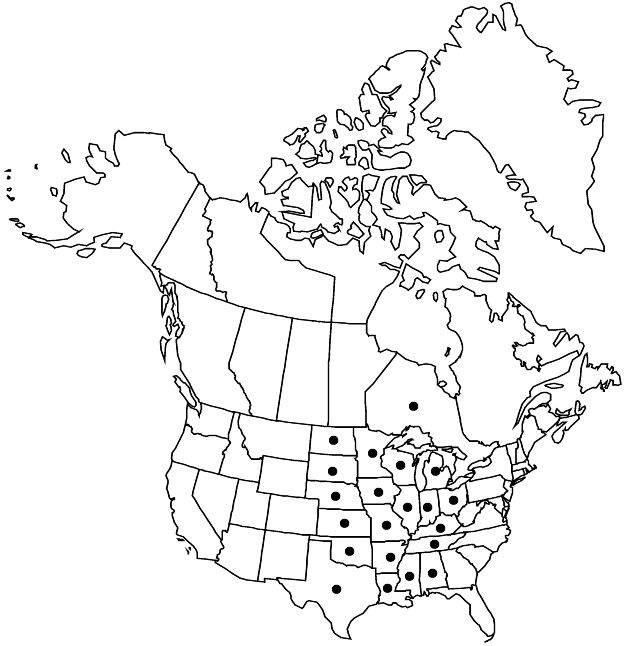Crataegus mollis
Linnaea 21: 569. 1848.
Shrubs or trees, 40–100 dm. Stems: trunk bark fibrous, checked into longitudinal plates, ± exfoliating or rough-corrugated; compound thorns on trunks frequent in some populations; twigs: new growth tomentose young, glabrescent, 1-year old tan, older pale gray; thorns on twigs absent or frequent, rarely plentiful, ± straight or ± recurved, 2-years old blackish brown, graying with age, usually ± stout, 3–6 cm. Leaves: petiole length 40–50% blade, tomentose young, tomentose to glabrate mature, usually eglandular; blade ± elliptic to ± ovate or suborbiculate, 4–8 (–12) cm, thin to chartaceous, base truncate to cuneate, lobes 0 or 2–6 per side, sinuses shallow to deep, lobe apex acute to obtuse, margins strongly serrate, teeth eglandular, veins 4–7 (–9) per side, apex acute to obtuse, abaxial surface pubescent young, densely so on veins, adaxial densely scabrous-pubescent young, densely scabrous-pubescent or glabrous mature. Inflorescences 5–15-flowered; branches tomentose; bracteoles caducous, greenish, linear-lanceolate or narrowly oblong, thin, larger ones subherbaceous, narrowly oblong, membranous to subherbaceous, margins short-stipitate or sessile-glandular, multiveined, abaxially pubescent. Flowers 20–25 mm diam.; hypanthium densely tomentose; sepals narrowly triangular, 6 mm, margins glandular-serrate to glandular-laciniate, abaxially pubescent; petals white, sometimes pink at late anthesis; stamens (10 or) 20, anthers ivory-cream; styles (3–) 5. Infructescences: fruiting pedicels pubescent. Pomes bright red, sometimes orange-red or deep red, rarely yellow, suborbicular, often tapered at base, 8–14 mm diam., ± tomentose; sepals obsolescent or erect-patent; pyrenes (3–) 5.
Distribution

Ont., Ala., Ark., Ill., Ind., Iowa, Kans., Ky., La., Mich., Minn., Miss., Mo., N.Dak., Nebr., Ohio, Okla., S.Dak., Tenn., Tex., Wis.
Discussion
Varieties 5 (5 in the flora).
Crataegus mollis is common and widespread west of the Appalachians from eastern South Dakota to extreme southwestern Ontario, to southern Texas and central Alabama. It is rare in the southeastern part of its range. Sporadic records to the east of this are misidentifications or recent introductions.
Crataegus mollis has 20, or, in one unusual form, 10, cream anthers and is distinguished from the superficially similar 10-stamen C. submollis by lack of pedicel glandularity and stamen number and from pink-anthered taxa of restricted range such as C. texana varieties by anther color. Whether C. mollis is truly distinct from the C. texana complex will require biosystematic work. Crataegus mollis is less glandular than the allopatric C. submollis, from which it differs in further ways (see 52. C. submollis). Crataegus canadensis, from Quebec, but with glandular petioles, could key out here and is treated as a form of C. submollis.
Crataegus mollis is variable in leaf shape and size; other characters are more constant. Northern plants are more floriferous, and their trunk bark is more exfoliating than southern ones, which have a more rough-corrugated bark. The leaves are usually shortest and proportionately widest in Texas. Larger and proportionately narrower leaves are found northeastward. The most superficially distinct form is var. incisifolia, with acute lobes and deep sinuses. The lobing varies from very small to absent in var. dumetosa and C. invisa Sargent. Crataegus meridionalis from Alabama and Mississippi is somewhat similar to var. dumetosa but has longer, elliptic to narrowly ovate, sharply serrate, rather coriaceous leaves.
Selected References
None.
Lower Taxa
Key
| 1 | Thorns on twigs few to plentiful; twigs ± strongly flexuous; leaf blades elliptic to narrowly ovate. | Crataegus mollis var. meridionalis |
| 1 | Thorns on twigs absent or few; twigs ± straight; leaf blades ± ovate or suborbiculate to broadly elliptic | > 2 |
| 2 | Leaf blades: lobes 4–6 per side, sinuses deep (LII 20–40%). | Crataegus mollis var. incisifolia |
| 2 | Leaf blades: lobes 0 or obscure, or 2–4 per side, sinuses ± shallow (LII 0–20%) | > 3 |
| 3 | Pomes yellow. | Crataegus mollis var. viburnifolia |
| 3 | Pomes red | > 4 |
| 4 | Leaf blades: lobes 2–4 per side, sinuses shallow (LII 8–20%). | Crataegus mollis var. mollis |
| 4 | Leaf blades: lobes 0 or obscure, sinuses shallow (LII 0–8%). | Crataegus mollis var. dumetosa |
"pubescent" is not a number."thin" is not a number."thin" is not a number."tomentose" is not a number."adnate" is not a number."dm" is not declared as a valid unit of measurement for this property.